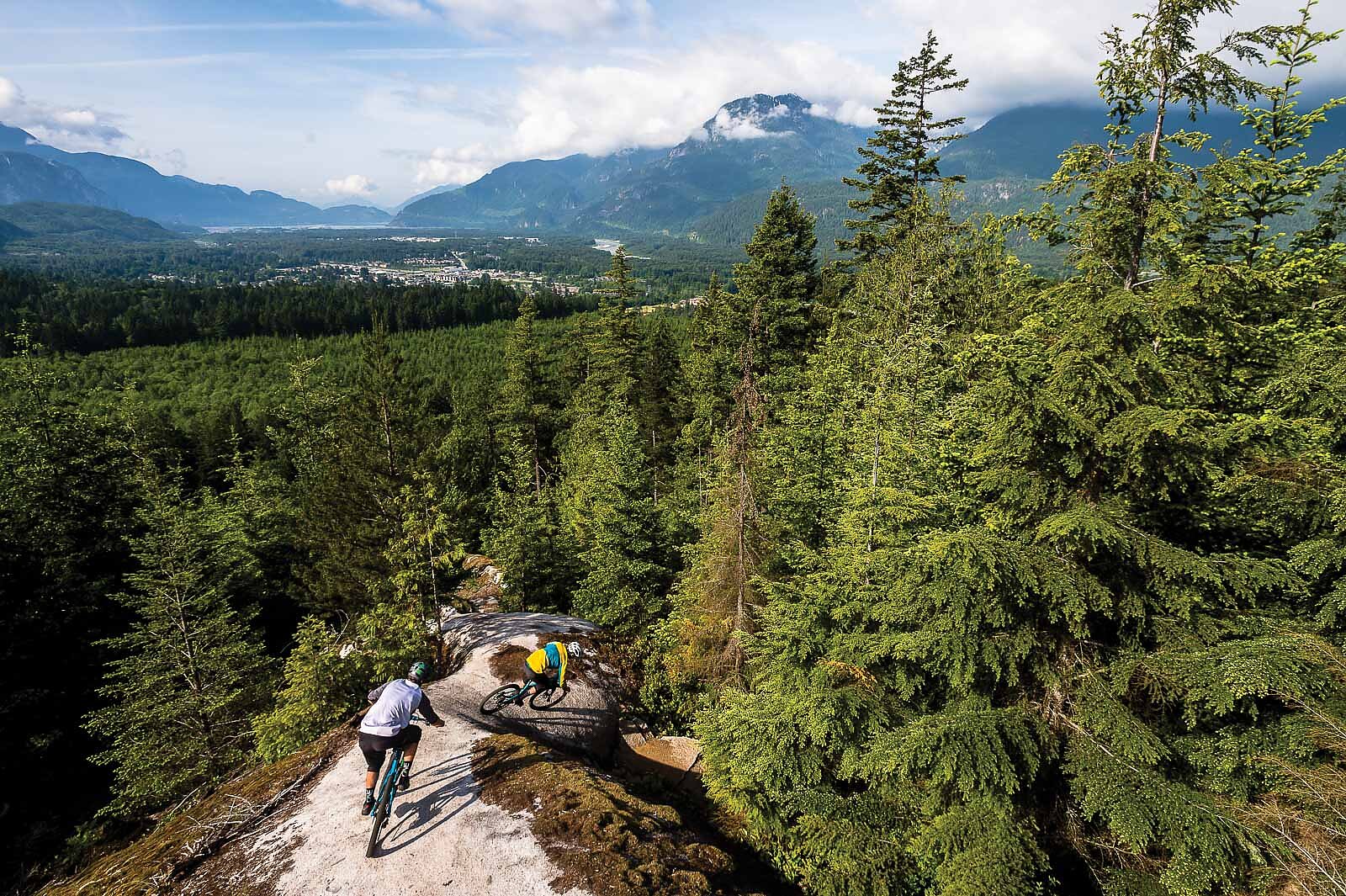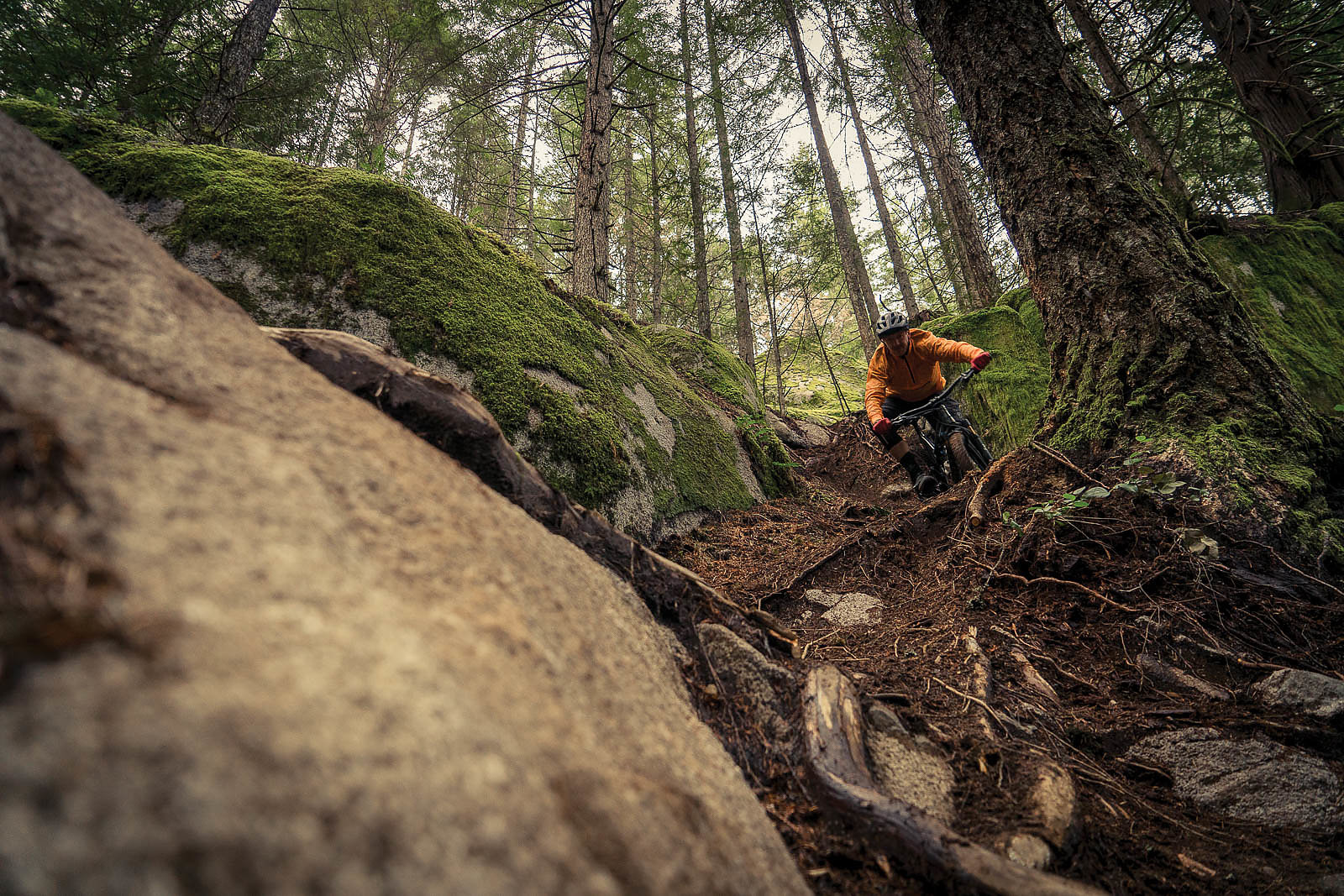
A Bright Future Visionary Land Management in Squamish, BC
Words by Ben Osborne
The next time you find yourself riding in a Squamish bike lane, look down.
The bike logo looks a bit different than the average—front fork, rear shock and even some extra-knobby tires—and is just one small piece of a pie that makes Squamish one of the most progressive and quirky mountain bike towns in North America.
When settlers first moved to Squamish for its conveniently located port and surplus of lumber, nobody thought the town would stick around long. The area that is now Squamish's downtown used to flood regularly due to a layout that echoed the lack of foresight of many early boom-and-bust mining towns. Today, more than 70 of the town's businesses are “bike-related” and in 2016 mountain-bike-related tourism generated $10 million in revenue.
In the early days, as nearby Vancouver grew and the timber industry blossomed along with mining, people began to flock to the Sea-to-Sky Corridor for its natural beauty. Eventually, Whistler opened and became one of the most renowned ski resorts in North America. What followed for mountain biking was revolutionary, with Whistler creating game-changing trails and eventually a bike park that would attract riders from all over the world. While much of the focus in the corridor was on Whistler, Squamish attracted plenty of riders, and quietly evolved a powerhouse trail network that has become integral to a quintessential Sea-to-Sky vacation—ride the Whistler Bike Park, check out Squamish’s iconic Alice Lake network, and finally test your mettle on the historic North Shore.
For a town that wasn’t built to last, Squamish has surpassed expectations and now has a bright future. Developments sprout up as rapidly as Canadians are growing their now-legal marijuana, and the only thing spreading as quickly as the aforementioned buds might be the trail networks. Growth and expansion, however, come with challenges. Last fall, at the end of Perth Drive, a popular entrance to the Alice Lake Network, a large fence was installed with a sign that read: “THIS IS PRIVATE PROPERTY”
Facebook groups lit up with anger, confusion, sadness and comment threads too long to follow. Then, Squamish Off-Road Cycling Association (SORCA) stepped in. With a town full of riders and plenty of money invested in the trail system, to some, SORCA might be more important than the local government. As the overseeing trail organization in a town that is undergoing rapid development, natural-resource extraction and mostly under the umbrella of the traditional territory of the Skwxwú7mesh Úxwumixw, SORCA’s political positioning is complex. The organization’s annual elections garner plenty of attention, and the former president of SORCA left his post to run for the mayor of Squamish, a reminder of how important SORCA is to the fate of Squamish itself.

The Alice Lake Trail Network is a complex mix of provincial crown, Squamish First Nation, and privately held lands. The area in question is a swath of private land that holds numerous classic trails and serves as the connection between Perth Drive and the rest of the network. It is owned by the Cheema family, who purchased it on the cheap from a logging company because it was zoned for neither logging nor development. The land still is not zoned for development, but with the direction Squamish is moving, the Cheemas believe the time has come to begin the rezoning process.
In the meantime, they have graciously allowed the existing trail system to remain intact. While some people’s gut-level reaction might be to boycott future development in the name of trails, SORCA President Jeff Norman and the executive team took a more carefully calibrated approach.
“The land use in this area is already designated for future residential development—it will happen eventually,” Norman says. “If as mountain bikers and other trail users we want to continue to have access to many of the lands around town, working collaboratively with landowners is the best option.”
As with many issues involving land use, opinions vary, and the matter remains a point of contention in the Squamish community. However, SORCA’s position is clear. So, on the brink of being cut off from an iconic trail network after the private property signs went up, SORCA opted for a collaborative approach; they initiated a conversation with the Cheema family and emerged with a visionary solution. The idea: to create a ride-in, ride-out community, trail reserve and potential new road connection to the Sea-to-Sky Highway.
“SORCA is not anti-development, and we aren’t pro-development either,” Norman says. “We simply want what is best for our trail system, and we believe this is a win for everyone.”
In a town that is developing rapidly and a world that seems to offer more problems than solutions, the Cheema Lands plan is a refreshing take on dealing with the ageold struggle to protect natural spaces in the face of development. The plan would preserve more than 90 percent of the trail system (and, most importantly, the infamous slab trails in the lower part of the network), while allowing for development of resedential space, commercial hubs and even a school. It is a model solution for the problems that many of the trail networks we cherish could eventually face due to population growth and the attendant need for more and greater development.
While the plan is still in its beginning stages—the land still must be rezoned, for instance—and the concerns of Squamish residents have yet to be addressed in full, the cooperation between SORCA and the Cheema family is an encouraging start. Planning for the future of mountain biking while preserving land and accommodating more people is a fine balance, and this seems like a step in the right direction.
Visit sorca.ca for updates, and be sure to support your local trail stewards.